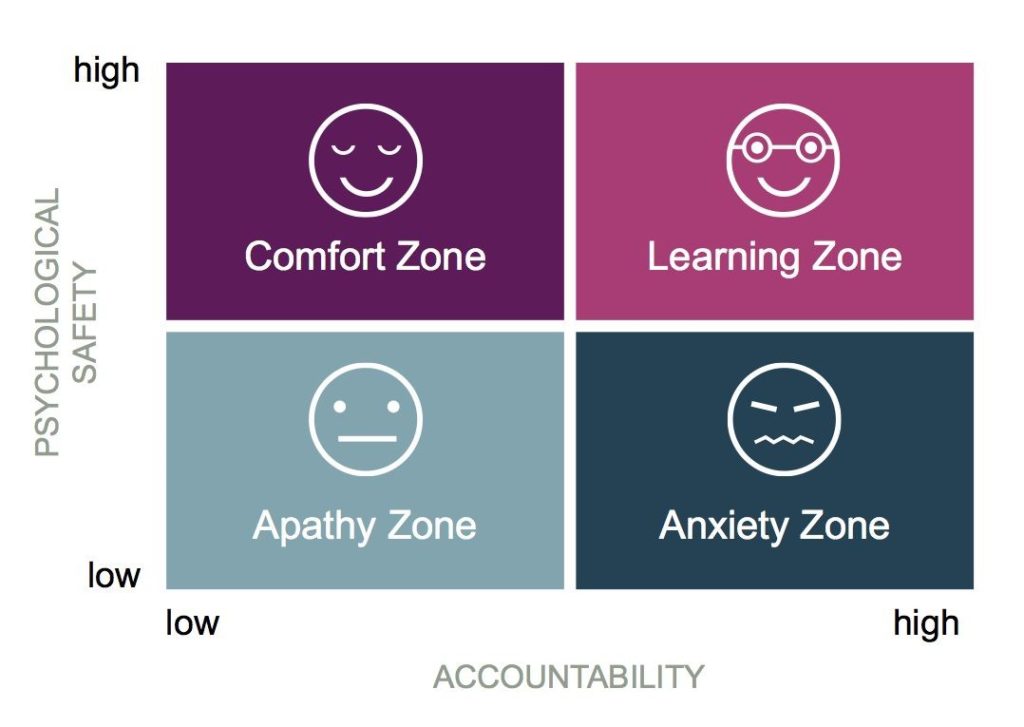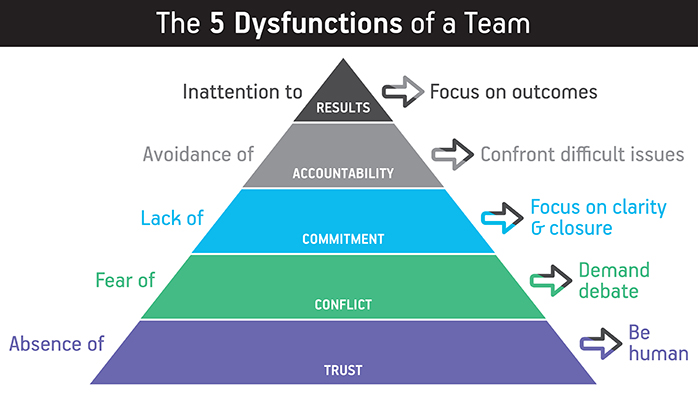Coaching Safety: Create A Safe and Comfortable Work Environment
By Team Lean Agile Intelligence

Creating A Comfortable Work Environment
Creating a comfortable work environment where people feel at ease and safe to speak up at work is critical for building a high-performing team.
In this blog post, we explore the concept of Coaching Safety and how coaches can use foundational and advanced techniques to facilitate team-building activities, start meetings on a positive note, and foster trust. Whether you're just starting or are an experienced coach, these techniques can help you create a safer, more productive team environment. For a thorough assessment of your current coaching process status, we offer a free agile assessment for Scrum Masters and Agile Coaches that you can take advantage of.
Coaching Safety and The Learning Journey
At Lean Agile Intelligence, we prioritize Coaching Safety as the individual's capacity to foster a comfortable work environment that encourages open communication and collaboration, free from any fear of negative repercussions. We divided the learning journey into 4 different stages: Developing, Emerging, Adapting, and Optimizing. In the following sections, we will discuss each stage in detail as well as provide practical tips and techniques to help you strengthen your skills in this area.

Source - Cultivating Psychological Safety in Agile Teams
Developing
A coach “developing” an understanding of the value of Coaching Safety and adopting the foundational techniques should focus on the following improvements:
-
The What: Facilitates team-building activities for teams to get to know one another and start to build trust
-
The How: Building vulnerability-based trust in a team involves creating an environment where members feel comfortable being open and honest about their thoughts, feelings, and opinions without fear of judgment or retribution. Here are some steps you can take to build vulnerability-based trust on your team:
-
Lead by example: As a leader, model the behavior you want to see from your team. Share your own vulnerabilities and mistakes to show your team that it's okay to be open and honest about their own weaknesses.
-
Create a safe space: Establish a safe environment where team members can speak freely without fear of criticism or punishment. Encourage open communication and active listening by creating ground rules for respectful communication and conflict resolution.
-
Encourage vulnerability: Encourage team members to share their thoughts and feelings openly, even if it means being vulnerable. Reward honesty and encourage team members to support each other. A straightforward technique to start with is the practice of "personal maps" by Jurgen Appelo
-
Celebrate successes and failures: Celebrate the successes of your team, but also acknowledge failures as opportunities for growth and learning. Help your team learn from their mistakes and encourage them to share what they've learned with others.
-
Foster trust: Build trust by being dependable, following through on commitments, and being transparent with your team. Show your team that you trust them by delegating tasks and responsibilities, and by recognizing their accomplishments.
-
-
-
The What: Starts meetings on a positive note (i.e., Prime Directive) to set the stage for an effective gathering where people feel safe
-
The How: The Prime Directive is designed to help teams reflect on their work and improve their performance. It was developed by Norm Kerth, an Agile software development expert, and is often used in Agile and Scrum development methodologies. The Retrospective Prime Directive reads as follows:
"Regardless of what we discover, we understand and truly believe that everyone did the best job they could, given what they knew at the time, their skills and abilities, the resources available, and the situation at hand."
The purpose of the Prime Directive is to create a safe and non-judgmental environment for team members to reflect on their work and identify areas for improvement. It encourages team members to focus on their work's positive aspects and view mistakes or failures as opportunities for learning and growth. By acknowledging that everyone did their best given the circumstances, team members can avoid blaming each other and instead work together to solve problems and improve their performance.
-

Source - 5 Dysfunctions of a Team
Emerging
A coach “emerging” beyond the foundational techniques of Coaching Safety and embracing it as they become more proficient should focus on the following improvements:
-
The What: Uses facilitation techniques to bring equal discussion and idea generation so everyone is engaged and has a say
-
The How: A coach needs to understand the personalities of team members and how people operate within meetings and use this information to create meetings that have input from all attendees, not just a few. The first step is to coach how to design a meeting using divergent and convergent techniques. Divergent techniques are designed to bring out as many ideas as possible for brainstorming, and convergent techniques are used to refine the concepts to action. You may want to choose different techniques based on the team members' personalities. A starter list of methods can be found here.
-
The What: Is well-versed in the research related to the correlation between high-performing teams and safety (i.e., Google's Project Aristotle)
-
The How:
-
Psychological safety: Psychological safety refers to an individual’s perception of the consequences of taking an interpersonal risk or a belief that a team is safe for risk-taking in the face of being seen as ignorant, incompetent, harmful, or disruptive. In a team with high psychological safety, teammates feel safe to take risks around their team members. They feel confident that no team member will embarrass or punish anyone else for admitting a mistake, asking a question, or offering a new idea. The criticality of this should not be understated. It was the number one thing Google found that led to higher team performance. You can read more about this in-depth here.
-
In Patrick Lencioni’s book “The Five Dysfunctions of a Team,” he details the five fundamental dysfunctions that prevent a team from becoming high performing. At the base of the model is the “absence of trust.” In particular, vulnerability-based trust. More details can be found here.
-
In the above post, there are ten key steps listed based on Lencioni’s work. Those steps are:
-
Reduce the amount of gossip and talking about one another behind their backs.
-
Admit when you are wrong, make mistakes, and readily apologize.
-
Let go of holding grudges from the past.
-
Understand and appreciate one another's work styles and strengths.
-
Be open and practice information sharing.
-
Take time to learn about each other on a more personal level.
-
Looks for ways to give credit to others.
-
Acknowledge and celebrate the successes of others.
-
Share both your failures and successes openly.
-
Give your team members the benefit of the doubt before jumping to a negative conclusion.
-
The What: Teaches conflict resolution strategies and facilitates conflict resolution sessions
-
The How:
-
"Constructive conflict" refers to a conflict managed and resolved positively and productively, leading to improved outcomes and relationships. Many available resources discuss this concept in more detail, including academic articles, books, and online resources. Here are a few places to start:
-
"The Five Dysfunctions of a Team" by Patrick Lencioni (Jossey-Bass, 2002) - This book offers a model for building high-performing teams. It focuses on constructive conflict as a critical component.
-
"How to Manage Conflict in the Workplace: Effective Resolution Techniques" by MindTools - This online resource offers practical tips and strategies for managing conflict constructively, including active listening, reframing, and collaboration.
-
"Tips and tools for Constructive Conflict Resolution" by The University of Michigan - This online resource provides a comprehensive overview of constructive conflict, including definitions, benefits, and strategies for positively managing conflict.
* * * * * *
"A coach needs to understand the personalities of team members and how people operate within meetings and use this information to create meetings that have input from all attendees, not just a few."
* * * * * *
Adapting
A coach that is “adapting” the Coaching Safety to extract the full benefit should focus on the following improvements:
-
The What: Helps develop an effective process for raising impediments to leaders with the necessary information
-
The How:
-
An impediment process should start with clearly defining what an "impediment" means and adding it to the team's definition of workflow.
-
Establish working agreements or processes with leadership regarding how impediments will be communicated, such as cadence, tooling, meetings, etc.
-
Work with the team to focus on daily proactive impediment identification. Focus on Work Item Age is a great way to get started.
-
The What: Coaches others to use information radiators to keep progress, plans, and deliverables visible
-
The How: An information radiator is a visible display of information that helps to keep teams informed and aligned. The term "information radiator" was coined by Alistair Cockburn in his book, "Agile Software Development: The Cooperative Game". The purpose of an information radiator is to provide real-time information so that everyone is aware of the current state of progress, plans, and deliverables. Examples of information radiators include but are not limited to Kanban boards, sprint backlogs, burn-down charts, metrics, forecasts, story maps, and team calendars.
-
The What: Coaches others to use information radiators to keep progress, plans, and deliverables visible
-
The How: An information radiator is a visible display of information that helps to keep teams informed and aligned. The term "information radiator" was coined by Alistair Cockburn in his book, "Agile Software Development: The Cooperative Game". The purpose of an information radiator is to provide real-time information so that everyone is aware of the current state of progress, plans, and deliverables. Examples of information radiators include but are not limited to Kanban boards, sprint backlogs, burn-down charts, metrics, forecasts, story maps, and team calendars.
-
The What: Coaches others to run small experiments (i.e., process change, technology adoption, deliverable) so they can accrue learnings.
-
The How: Use an empirical approach to run small experiments with the following four steps.
-
Identify the problem to solve
-
Example: We have more escaped defects than we anticipate, or that's acceptable
-
Hypothesize
-
Example: We believe that by increasing our unit test coverage and integrating more often, we will see fewer escaped defects due to faster quality feedback.
-
Test the Hypothesis
-
Example Tests: Improve Continue Integration tooling and education, Create a working agreement for unit testing, Use Gated Check-ins.
-
Review Data and Adjust
-
Example Leading Indicators: Builds per day, Builds per day / Broken Builds, Unit test coverage
Optimizing
A coach “optimizing” knowledge sharing of the Coaching Safety practice learnings across the enterprise should focus on the following improvements:
-
The What: Teaches and shares advanced techniques to create Safety outside of those they directly support (i.e., Communities of Practice, Workshops, Mentoring)
-
The How: The Agile Coach has been relentlessly spreading best practices by coaching leadership on effectively Creating Safety, and the practice has been demonstrably improved throughout the organization.
* * * * * *
"As a leader, model the behavior you want to see from your team. Share your own vulnerabilities and mistakes to show your team that it's okay to be open and honest about their own weaknesses."
* * * * * *
Conclusion
In conclusion, creating a comfortable work environment is crucial for fostering a positive and productive workplace culture. As a leader, it's important to make people feel at ease and safe to speak up at work, which can be achieved by coaching safety. Ultimately, prioritizing a comfortable work environment can lead to increased employee satisfaction, improved teamwork, and better business outcomes. Our free agile assessment for Scrum Masters and Agile Coaches provides a complete overview of your coaching process status, so if you're interested, give it a try.
